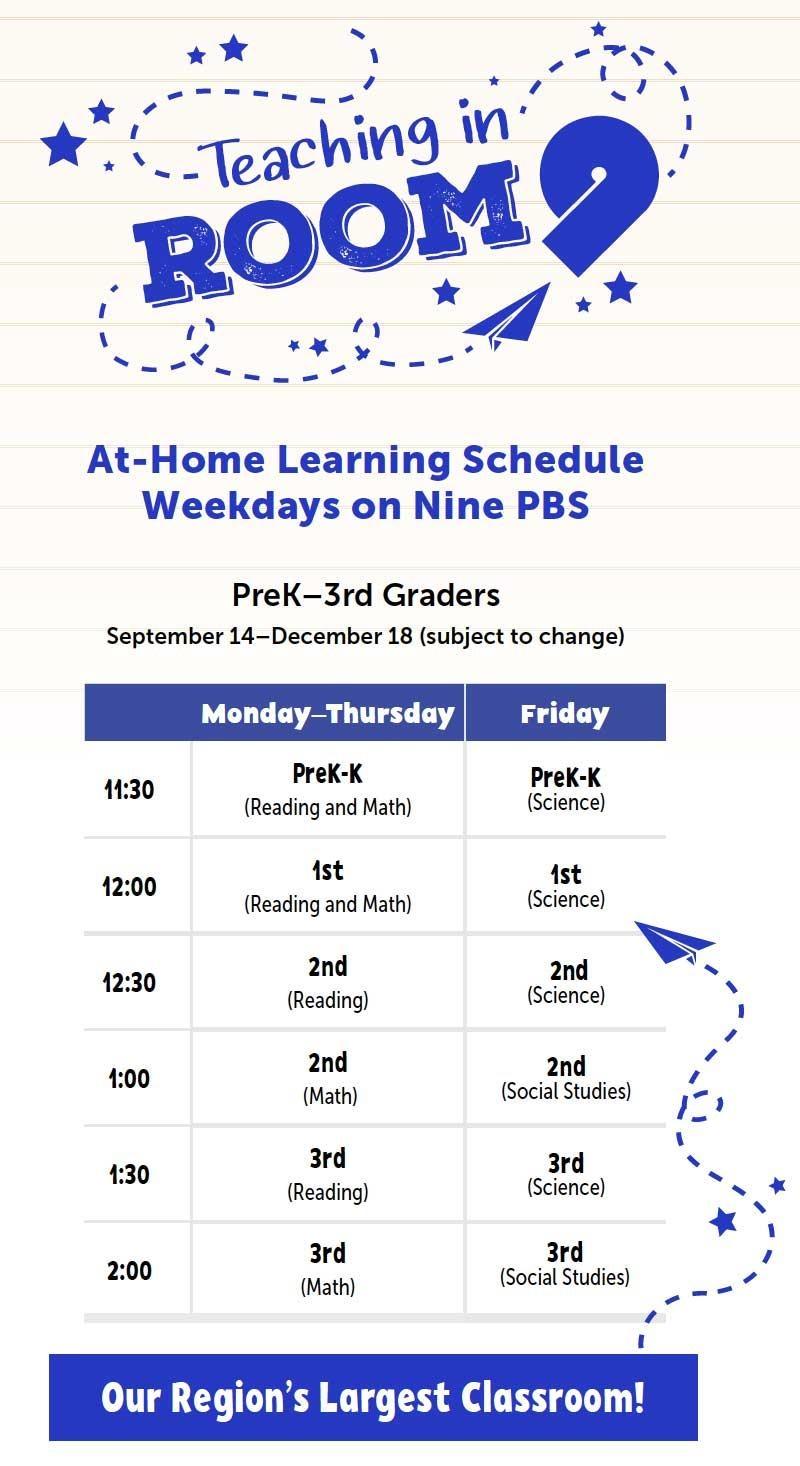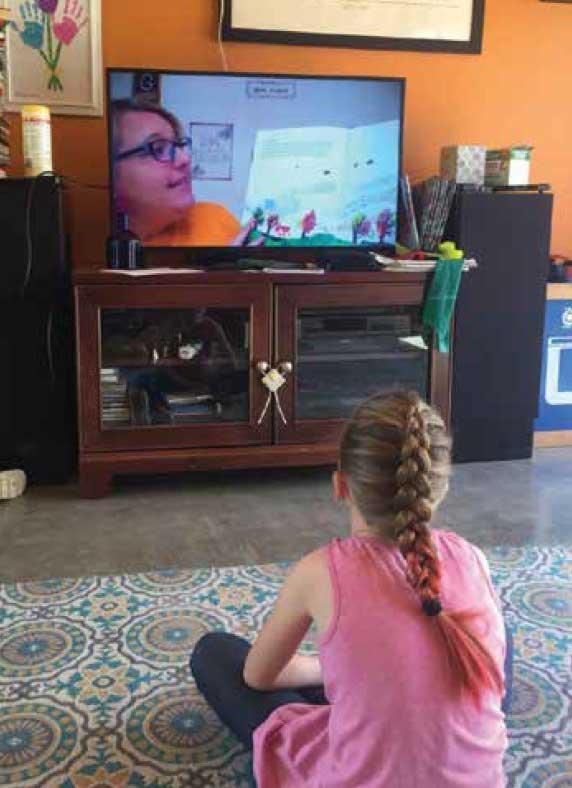Back to School in the Safety of Home | Nine Magazine


During the schooling crisis created by the coronavirus pandemic, Nine was called on by school districts and educators to respond to the needs of early learners. Nine, whose top priority is serving the educational needs of children, jumped into action immediately. We developed an online Educator and Caregiver Toolkit, but the real game-changer was Teaching in Room 9.
Nine's on-air classroom has the potential to reach every student, family, and educator, making us the region's largest classroom. Consistency is also important, says Dr. Samantha March, Interim Director of Early Childhood Education, Saint Louis Public Schools. "Teaching in Room 9 has been extremely helpful...because a consistent routine of strong educational content is aired daily," she says. "Being able to participate in lessons at the same time on the same network daily provides students with the stability that they comfortably had in classrooms."
Lauren Williams, who teaches first grade at Windsor C-1 School District in Jefferson County, says being a part of Teaching in Room 9 was important to her because she saw a gap that needed to be filled. "I feel like Teaching in Room 9 gives students a kind of classroom community that they're missing. It gives them a safe place." And, it has provided a respite for parents who are stressed with juggling parental and teacher responsibilities. "Kids aren't just sitting in front of the television; they are getting curriculum and social emotional skills," she says.
"It's high-quality instruction that doesn't require anything extra," says Maggie Klonsky, former middle school teacher and parent to a 3-year-old and 6-year-old, except maybe paper and pencil. "There are no frills and bells, and yet the teaching is so good. It reminds me of the essence of what good teaching is when you have something that is just so engaging, because it's about curiosity and investigation," she says. "Teaching in Room 9 provides relevant content in an interactive manner. On-air educators intentionally use methods to keep students engaged throughout the lesson as if they were in the room together."
The pandemic has forced children to learn in unconventional ways. Some of the region's best educators accepted the challenge to record lessons from their homes for broadcast weekday afternoons on Nine PBS. Numerous lessons are available on Nine's YouTube channel as well. Nine is one of only four public media stations in the country airing locally developed lessons for kids.
Distance learning and online videos can seem impersonal. "The learning has not felt personal, and direct instruction and the guided practice have been missing," says Klonsky. Teaching in Room 9 gives an authentic experience that feels like you are interacting with a teacher in your family room. "My own children, who do not know the teachers, feel like they're interacting with them personally," she says.
Teachers are doing heroic work, and our community can take pride in the educators in Teaching in Room 9. Klonsky believes Nine did a thoughtful job curating exemplary educators who have wonderful skills and relationships with children in their schools and districts.
Art McCoy, PhD, superintendent of schools, Jennings School District, says the Nine team has really stepped up. "They were instrumental in reaching out to get some of the best and brightest teachers. Nine helps make sure we have the tools to help educators still reach students."
Nine has always believed in the promise of all kids in our region and providing education opportunities so that kids can succeed in school and in life. Nine has a history of innovation in educational television for children, including longstanding partnerships with regional educators. Back in 1952, the St. Louis Board of Education agreed to provide the first year of operational expenses for the fledging KETC educational television station (now Nine Network). Teaching in Room 9 lessons are informed by the Missouri Department of Elementary and Secondary Education (DESE) and education leaders across the region so that key parts of the public-school curriculum are covered in these broadcasts.
The goal was to provide high-quality learning resources for children, especially the 1 in 3 children in our region without reliable internet or devices. Since launching Teaching in Room 9 in late April through July 31, 279 episodes have aired featuring lessons in literacy, math, and science. They have been watched 477,905 times by kids ages 2-11. Now that this year's back-to-school plans have been impacted by COVID-19, Nine will continue Teaching in Room 9 at least through the end of the year.
"I'm continually impressed by Nine's thoughtfulness around educating the whole child, and also our whole community, and making sure that they're thoughtful about how they're curating their resources and the people that they choose to interact with in different spaces, who they choose to go to for expertise, and how they implement their programs," says Klonsky.
The public health crisis has created "stressful times of uncertainty and difficulty" for families, says March. "Families have had to navigate through ambiguous factors such as housing, income, food, and obtaining Wi-Fi and devices. Teaching in Room 9 has proven to be a reliable source of education during the pandemic because the easy accessibility nearly eliminates the digital divide families are facing."
Teaching in Room 9 is supported by Bank of America, the Dana Brown Charitable Trust, and Emerson in partnership with Missouri Department of Elementary and Secondary Education, regional district and education leaders, Washington University Institute for School Partnership, Crabtree Publishing, and St. Louis Black Authors of Children's Literature.
This article appeared in the September/October 2020 issue of Nine Magazine.

"They were instrumental in reaching out to get some of the best and brightest teachers. Nine helps make sure we have the tools to help educators still reach students."
—Art McCoy, PhD Superintendent of Schools, Jennings School District


"Teaching in Room 9 provides relevant content in an interactive manner. On-air educators intentionally use methods to keep students engaged throughout the lesson as if they were in the room together."
—Maggie Klonsky Former middle school teacher and parent